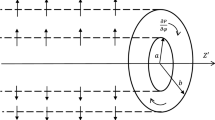Abstract
This paper studies similarity solutions for pulsatile flow in a tube with wall injection and suction. The Navier-Stokes equations are reduced to a system of three ordinary differential equations. Two of the equations represent the effects of suction and injection on the steady flow while the third represents the effects of suction and injection on pulsatile flow. Since the equations for steady flow have been studied previously, the analysis centers on the third equation. This equation is solved numerically and by the method of matched asymptotic expansions. The exact numerical solutions compare well with the asymptotic solutions.
The effects of suction and injection on pulsatile flow are the following: a) Small values of suction can cause a resonance-like effect for low frequency pulsatile flow. b) The annular effect still occurs but for large injection or suction the frequency at which this effect becomes dominant depends on the cross-flow Reynolds number. c) The maximum shear stress at the wall is decreased by injection, but may be increased or decreased by suction.
Similar content being viewed by others
Abbreviations
- a :
-
radius of the tube
- a 20 :
-
iεα 2
- A0, B0, C0, D0, E0 :
-
constant coefficients appearing in the expression for pressure
- b :
-
a non-dimensionalized length
- b 20 :
-
iε 2 α 2
- b k :
-
complex coefficients of a power series
- B :
-
\(\sqrt { - i\alpha ^2 } \)
- C 1, C 2, D :
-
complex constants
- d :
-
\(\frac{{B_0 a^2 }}{{4vV}}\)
- D 1,2 :
-
\( \pm \frac{1}{2}\left( {1 \mp r_0 {\text{ cos }}\frac{\theta }{2} \mp ir_0 {\text{ sin}}\frac{\theta }{2}} \right)\)
- f(η):
-
F(aη 1/2)/aV
- f 0,f 1,...:
-
functions of order one used in asymptotic expansions of f(η)
- F(r):
-
rv r
- g(ξ):
-
\(\frac{{F(a\eta ^{\frac{1}{2}} )}}{{aV}}\)
- G(r):
-
a steady component of velocity in axial direction
- h(η):
-
4ν/C0 a 2 H(aη 1/2)
- h 0,h 1,h 2,...;l 0,l 1,l 2,...:
-
functions of order one used in asymptotic expansions for h(η) in outer regions
- H(r):
-
complex valued function giving unsteady component of velocity
- H 0, H 1, H 2, ... K 0, K 1, K 2, ...; L 0, L 1, L 2, ...:
-
functions of order one used in asymptotic expansions for h(η) in inner regions
- i:
-
\(\frac{R}{2}f\left( {\frac{\xi }{b}} \right)\)
- J 0, J 1, Y 0, Y 1 :
-
Bessel functions of first and second kind
- k :
-
\(\sqrt { - 1} \)
- K :
-
Rk/2b 2
- O:
-
order symbol
- p :
-
pressure
- p 1(z, t):
-
arbitrary function related to pressure
- r :
-
radial coordinate
- r 0 :
-
(1+16ε 4 α 4)1/4
- R :
-
Va/ν, the crossflow Reynolds number
- t :
-
time
- u(η):
-
G(r)/V
- v r :
-
radial velocity
- v z :
-
axial velocity
- V :
-
constant velocity at which fluid is injected or extracted
- z :
-
axial coordinate
- α 2 :
-
ωa 2/4ν
- β :
-
4.196
- ε :
-
small parameter; ε=−2/R (Sect. 4); ε=−R/2 (Sect. 5); ε=2/R(Sect. 6)
- η :
-
r 2/a 2
- η*:
-
0.262
- θ :
-
Arctan (4ε 2 α 2)
- λ, τ :
-
inner variables
- ν :
-
kinematic viscosity
- ξ :
-
bη
- ξ*:
-
zero of g′(ξ)
- ρ :
-
density
- φ(r, t):
-
arbitrary function related to axial velocity
- ω :
-
frequency
References
Yuan, S. W. and A. B. Finkelstein, Trans. ASME 78 (1956) 719.
Eckert, E. R. G., P. L. Donoughe, and B. J. Moore, Velocity and friction characteristics of laminar viscous boundary-layer and channel flow over surfaces with ejection or suction. NACA TN 4102, NACA, Washington, D. C. (1957).
Morduchow, M., Quart. J. Appl. Math. XIV (1957) 361.
Berman, A. S., Effects of porous boundaries on the flow of fluids in systems with various geometries. Proceedings Second United Nations International Conference on the Peaceful Uses of Atomic Energy, Geneva 4 (1958) 351.
White, F. M., J. Appl. Mech. 29 (1962) 201.
Peng, Y. and S. W. Yuan, J. Heat Transfer 87 (1965) 252.
Kinney, R. B., Int. J. Heat Mass Transfer 11 (1968) 1393.
Terrill, R. M. and P. W. Thomas, Appl. Sci. Res. 21 (1969) 37.
Raithby, G., Int. J. Heat Mass Transfer 14 (1971) 223.
Terrill, R. M., Quart. J. Appl. Math. XXVI (1973) 347.
Skalak, F. M., Pulsatile flow in a uniformly porous tube, Ph.D. Thesis, Michigan State University, East Lansing, Michigan, USA, 1975.
Richardson, E. G. and E. Tyler, Proceedings of the Physical Society 42 (1929) 1.
Sexl, T. Z., Phys. 61 (1930) 349.
Womersley, J. R., An elastic-tube theory of pulse transmission and oscillatory flow in mammalian arteries, Wright Air Development Center, WADC Rep. TR 563614, 1957.
Uchida, S., ZAMP VII (1956) 403.
Author information
Authors and Affiliations
Rights and permissions
About this article
Cite this article
Skalak, F.M., Wang, CY. Pulsatile flow in a tube with wall injection and suction. Appl. Sci. Res. 33, 269–307 (1977). https://doi.org/10.1007/BF00383957
Received:
Revised:
Issue Date:
DOI: https://doi.org/10.1007/BF00383957




